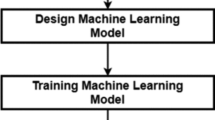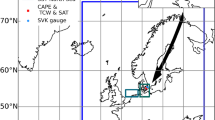Abstract
Global climate changes and the increase in average temperatures are some of the major contemporary problems that have not been considered in the context of external factors to increase accident risk. Studies that include climate information as a safety parameter in machine learning models designed to predict the occurrence of accidents are not usual. This study aims to create a dataset with the most relevant climatic elements, to get better predictions. The results will be applied in future studies to correlate with the accident history in a retail sector company to understand its impact on accident risk. The information was collected from the National Oceanic and Atmospheric Administration (NOAA) climate database and computed by a wrapper method to ensure the selection of the most features. The main goal is to retain all the features in the dataset without causing significant negative impacts on the prediction score.
Access this chapter
Tax calculation will be finalised at checkout
Purchases are for personal use only
Similar content being viewed by others
References
Aleksic, D., Markovic, M., Vasilijevic, M., Stojic, G., Pavlovic, N., Tanackov, I.: Analysis of impact of meteorological conditions on human factors in estimating the risk of railway accidents. Transport 33, 57–69 (2018). https://doi.org/10.3846/16484142.2017.1332684
Alruqi, W.M., Hallowell, M.R., Techera, U.: Safety climate dimensions and their relationship to construction safety performance: a meta-analytic review. Saf. Sci. 109, 165–173 (2018). https://doi.org/10.1016/j.ssci.2018.05.019
Antão, P., Calderón, M., Puig, M., Michail, A., Wooldridge, C., Darbra, M.R.: Identification of occupational health, safety, security (ohhs) and enviromental performance indicators in port areas. Saf. Sci. 85, 266–275 (2016)
Blanchard, D.: A smarter way to safety (2019). https://www.ehstoday.com/safety-technology/article/21920103/a-smarter-way-to-safety, (last accessed 10 January 2022)
Cioni, M., Sabioli, M.: A survey on semi-supervised feature selection methods. Work Employ Soc. 30, 858–875 (2016)
Commission, E.: Communication from the commission to the european parliament, the council, the european economic and social committee and the committee of the regions (2012). https://www.eea.europa.eu/policy-documents/communication-from-the-commission-to-1, (last accessed 20 January 2022)
Dy, J.G., Brodley, C.E.: Feature selection for unsupervised learning. J. Mach. Learn. Res. 5, 845–889 (2004)
Ferrara, E., Meo, P.D., Fiumara, G., Baumgartner, R.: Web data extraction, applications and techniques: a survey. Knowl. Based Syst. 70, 301–323 (2014)
Ferreira, A.J., Figueiredo, M.A.: Efficient feature selection filters for high-dimensional data. Pattern Recog. Lett. 33, 1794–1804 (2012). https://doi.org/10.1016/j.patrec.2012.05.019
Freitas, L.: Manual de segurança e saúde do trabalho. Sílabo (2016)
Irmak, U., Suel, T.: Interactive wrapper generation with minimal user effort. In: Proceedings of the 15th international conference on World Wide Web - WWW 2006, p. 553. ACM Press (2006). https://doi.org/10.1145/1135777.1135859
Jiang, L., Lavaysse, L.M., Probst, T.M.: Safety climate and safety outcomes: a meta-analytic comparison of universal vs. industry-specific safety climate predictive validity. Work Stress 33, 189–214 (2019)
Kohavi, R., John, G.H.: Wrappers for feature subset selection. Artif. Intell. 97, 273–324 (1997). https://doi.org/10.1016/s0004-3702(97)00043-x, https://www.sciencedirect.com/science/article/pii/S000437029700043X?pes=vor
Scikit Learn.: scikit-learn: Machine Learning in python (2022). https://scikit-learn.org/stable/index.html. Accessed 4 Apr 2022
Li, J., et al.: Feature selection: a data perspective. ACM Comput. Surv. 50, 1–45 (2017). https://doi.org/10.1145/3136625, https://arxiv.org/abs/1601.07996
Liu, H., Motoda, H.: Computational Methods of Feature Selection. Chapman and Hall/CRC. October 2007
NOAA: National oceanic and atmospheric administration, National Oceanic and Atmospheric Administration
Omondi, A., Lukandu, I.A., Wanyembi, G.W.: A monte carlo-based search strategy for dimensionality reduction in performance tuning parameters. J. AI Data Min. 8, 471–480 (2020)
Rose, N., Dolega, L.: It’s the weather: quantifying the impact of weather on retail sales. Appli. Spat. Anal. Policy 15, 189–214 (2022). https://doi.org/10.1007/s12061-021-09397-0
Sheikhpour, R., Sarram, M.A., Gharaghani, S., Chahooki, M.A.Z.: A survey on semi-supervised feature selection methods. Pattern Recogn. 64, 141–158 (2017)
Song, L., Smola, A., Gretton, A., Borgwardt, K.M., Bedo, J.: Supervised feature selection via dependence estimation. In: Proceedings of the 24th International Conference On Machine Learning - ICML 2007, pp. 823–830. ACM Press (2007)
Sánchez-Maroño, N., Alonso-Betanzos, A., Tombilla-Sanromán, M.: Filter methods for feature selection - a comparative study. Intell. Data Eng. Auto. Learn. IDEAL 2007, 178–187 (2007)
Weston, J., Elisseff, A., Schoelkopf, B., Tipping, M.: Use of the zero-norm with linear models and kernel methods andré elisseeff bernhard schölkopf mike tipping. J. Mach. Learn. Res. 3, 1439–1461 (2003)
Acknowledgments
This work has been supported by FCT—Fundação para a Ciência e Tecnologia within the Project Scope UIDB/05757/2020 and NORTE-01-0247-FEDER-072598 iSafety: Intelligent system for occupational safety and well-being in the retail sector.
Author information
Authors and Affiliations
Corresponding author
Editor information
Editors and Affiliations
Rights and permissions
Copyright information
© 2022 The Author(s), under exclusive license to Springer Nature Switzerland AG
About this paper
Cite this paper
Silva, F.G. et al. (2022). External Climate Data Extraction Using the Forward Feature Selection Method in the Context of Occupational Safety. In: Gervasi, O., Murgante, B., Misra, S., Rocha, A.M.A.C., Garau, C. (eds) Computational Science and Its Applications – ICCSA 2022 Workshops. ICCSA 2022. Lecture Notes in Computer Science, vol 13378. Springer, Cham. https://doi.org/10.1007/978-3-031-10562-3_1
Download citation
DOI: https://doi.org/10.1007/978-3-031-10562-3_1
Published:
Publisher Name: Springer, Cham
Print ISBN: 978-3-031-10561-6
Online ISBN: 978-3-031-10562-3
eBook Packages: Computer ScienceComputer Science (R0)




